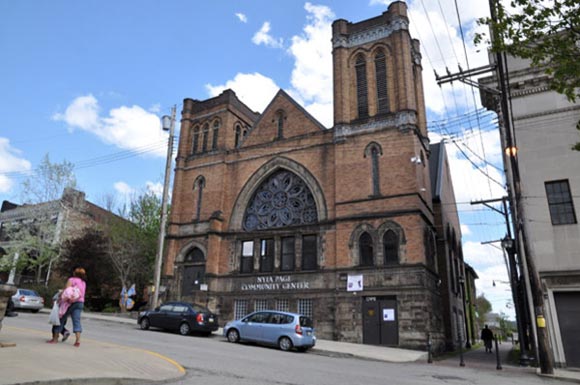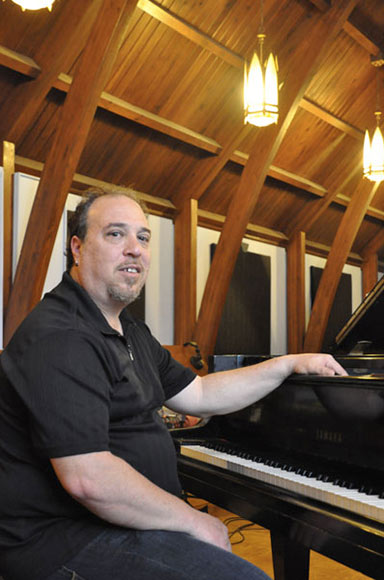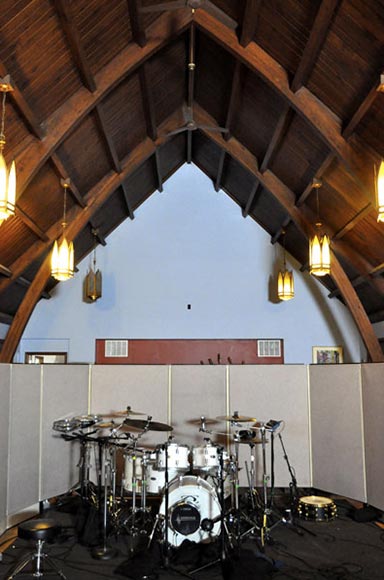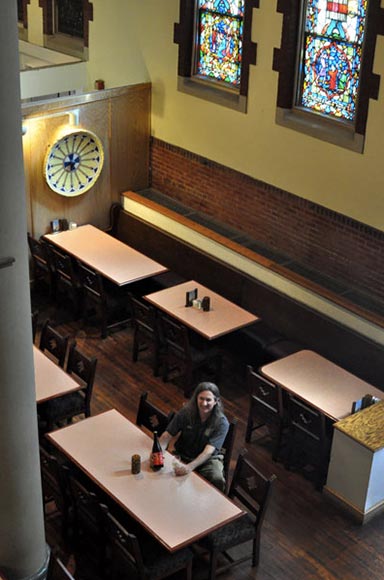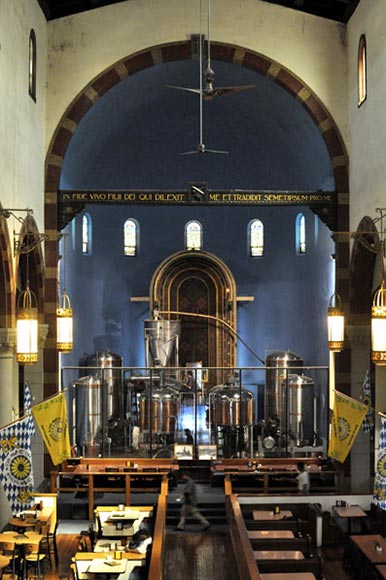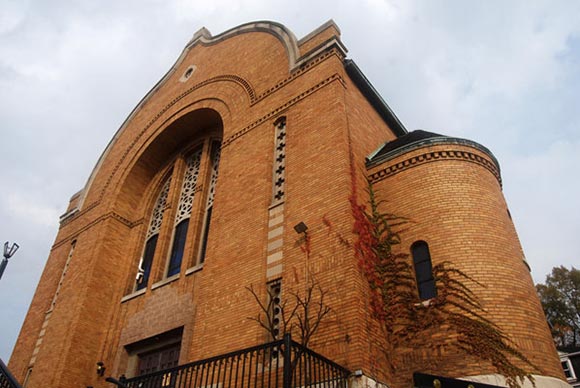On day in 1996, Giordano Riccobon was driving his usual commute when he came across a forlorn-looking old man carrying a ladder out of a small church. Riccobon stopped and asked him what was going on. “This is the saddest day,” Riccobon recalls the man saying. “It’s our last service. The congregation has shrunk to 40 people all in their 70s and we can’t make it anymore.”
The scene Riccobon came across is not an uncommon one. The Archdiocese of Pittsburgh lists on its website 158 parishes that have been dissolved since 1990.
In Riccobon’s case, the church was, fittingly, an answer to his prayers. He was teaching at Woodland Hills, living in Regent Square and had an art studio in Oakland. He was looking for a way to simplify and, though it was unconventional, converting and moving into the one-time Emanuel Lutheran Church in East Pittsburgh would put him closer to the school, give him enough square footage for a studio and living space under one roof and engage his serious love of DIY renovation. Fifteen years later, the church is his home, workspace and arguably his masterwork as an artist (more on him later).
For creative developers, a former church can become a residence, concert venue, restaurant or anything else. Some notable ex-houses of worship include Mark’s American Cuisine, a celebrated Houston restaurant; The Tabernacle, an Atlanta entertainment venue and Asbury Hall, a Buffalo concert hall run by city native Ani DiFranco.
While you might think an archdiocese or religious authority wouldn’t want to hand over a former spiritual center to the secular world, they often want to get decommissioned churches off their hands for the same reasons anyone would want to relinquish ownership of an abandoned building: reduce liability, pass on the costs of maintenance and spare the neighborhood a shuttered blight (in this case, a super-sized one).
“The Pittsburgh Presbytery was happy to give this space over for a fair price,” says Dana Cannone, owner of The Church Recording Studio, formerly the Overbrook Presbyterian Church, in Brookline. As for the former congregants: “I think they were just glad it wouldn’t become the neighborhood eyesore.”
More than a few local entrepreneurs created a business in a former church, facing the challenges imposed by the buildings’ unique architecture and considerable age.
The Church Brew Works
3525 Liberty Ave., Lawrenceville
Formerly Saint John the Baptist (1902 to 1993)
When Sean Casey sought to open a brewpub in the mid ’90s, he wanted to model it after those in Germany that had endured a few centuries. “I didn’t want something in a strip mall that would be gone in 20 years,” he says. “There are places at the heart of communities over there that have been serving the same purpose for generations.”
And one of the most seemingly well-anchored structures in Lawrenceville was up for the sale, the gargantuan former Saint John the Baptist Church. It had acted as a dispensary for foodstuffs during the Great Depression, sheltered residents during the Flood of 1936 and became a neighborhood hub when Lawrenceville grew into a prime residential area. Even if the Archdiocese of Pittsburgh could no longer maintain a parish there, it seemed impossible to imagine the neighborhood without the building.
Casey says the Archdiocese was eager to unload it and even vouched for him in front of the Liquor Control Board. A few priests still regularly lunch at the Brew Works.
During renovations, Casey sought “to highlight the inherent beauty of the building.” The pews were taken out for tables and at the site of the pulpit there are now shimmering vats (which gestate such cheekily named brews as Pipe Organ Ale and Celestial Gold), but otherwise the building has been kept utterly church-like.
This has presented a few challenges. The Brew Works’ dining area is one big room, which means no private parties, and echoes tend to carry. Great pains were taken to keep the piping and ventilation needed for the brewing invisible to patrons.
Casey gets calls and emails from entrepreneurs across the country seeking his advice on church-to-eatery renovations. He tells them that, while churches can make beautiful restaurants, owners should carefully consider logistics before adding a brewing operation. During renovations, he forbade contractors from knocking down any of the former church’s two-foot-thick walls. To get the vats in, they took the doors off the hinges and still only had half an inch clearance on either side when wheeling them through.
He says he plans to utilize some of the lessons learned when he finds another abandoned church for a second Brew Works outpost.
Mr. Small’s Funhouse
400 Lincoln Ave., Millvale
Formerly Saint Ann (1924 to 1998)
While the Brew Works represents a careful attempt to preserve the majesty of a former church, the owners of Mr. Small’s — Liz Berlin of local music luminaries Rusted Root and her husband Mike Speranzo — have been more attuned to function. The dark, cavernous interior retains the amphitheater-like aspects of a church — the balcony, the stage — but the rest was gutted. Pews have been stripped for a standing-room-only floor plan and to the side is a modest bar. They admittedly had less than Casey had to work with, given that their building had been shuttered for a few years before they opened Mr. Small’s in 2003.
Since then, the stage has hosted Muse, Anti-Flag, My Chemical Romance, Fall Out Boy, The Misfits and more— names that would make any mid-size venue proud.
The fact that Mr. Small’s is never lost. “Black metal bands think it’s funny,” says general manager Shaunden Smith, one of three full-time employees. “They like to swear just because it’s a church. They think it’s blasphemous.”
While many aspects of the place lend themselves well to its new life as a rock club, its location on a steep hill has been cursed by many a roadie. All sidewalks around Mr. Small’s are slanted, making it tough to roll through amplifiers and other gear. They Might Be Giants even wrote a song about it. “Mr. Small’s Theater/partly hoping, half afraid,” the famously quirky twosome sang. “We could rock it so well/We would roll down the hill.”
The Church Recording Studio
2020 Dartmore St., Brookline
Formerly Overbrook Presbyterian (1936 to 2003)
Rusted Root also plays a role in the story of The Church Recording Studio. Dana Cannone had served as a tour manager for the band (and had also done stints running the road shows of Government Mule, Art Garfunkel and others) when he feared the days of the road manager might be over.
“Most bands don’t have the money for that anymore,” he says. “They’re acting as their own road managers.”
Cannone decided to stay in the music business by opening a recording studio. When he saw that the Pittsburgh Presbytery was selling a small neighborhood church in the South Hills, he was interested — and not just because it was an available building.
“Churches are designed to have a reflective sound,” he says. “The non-panel walls and hardwood floors make for great acoustics.”
Where there were once pews there is now a room for recording group performances, centered by a grand piano. In place of the altar are individual sound booths and Cannone’s control room is in the former pulpit. In a space where messages were once given, they are now received.
Cannone specializes in jazz artists and, though he records the shows at the station’s South Side headquarters, he mixes WYEP’s “Live and Direct”compilations of in-house performances at The Church.
He has a guest apartment on site for artists who come to town, and the basement is his own residence, shared with a cat named Sgt. Pepper. Save for the industrial kitchen in one end, it’s essentially one room, but a seemingly endless one where he’s fit a bed area, a living room-type space and a huge dining room table that makes use of the pews as bench seating on two of its sides.
“When I was preparing this place and living in an apartment, the apartment felt like a coffin,” he says.
It makes you wonder why everyone doesn’t live in a former church. Cannone can answer that in one word: maintenance. The building is nearly 80 years old, and with all the repairs and yard work, he estimates he spends a day a week on upkeep. Also, with ceilings so high he needs a 20-foot ladder just to change a light bulb.
The Nyia Page Community Center
416 Library St., Braddock
Formerly First Presbyterian (dates uncertain)
Though there hasn’t been a congregation at the former First Presbyterian Church in Braddock in more than a decade, the building is still home to many of the socially enriching services a community church should provide.
Run by the nonprofit Braddock Redux, the Nyia Page Community Center houses a Head Start program, a playground, a gym and numerous after-school activities — which is pretty impressive given that ten years ago rain seeped in through the roof, debris covered the floors and the building was slated for demolition.
The development of the community center is tied at every step to Braddock’s slow-but-steady revival under John Fetterman, its hands-on, nationally known mayor with the physique of a nightclub bouncer.
After graduating Harvard with a masters in public policy, Fetterman first came to the depopulated, impoverished town, which bore the brunt of the near collapse of the American steel industry, on an AmeriCorps project. He stayed, founding Braddock Redux. The church was an object of fascination to him. “The building just spoke to me,” he says. Long ago, Andrew Carnegie had donated its pipe organ and other steel baron, Charles Schwab, purchased stain glass windows for the building. It seemed invariably linked to the spirit of Braddock.
Through Braddock Redux, Fetterman borrowed the funds to buy it, and he lived in its basement one long winter, surrounded by space heaters. It’s a living situation he says he “wouldn’t recommend.”
Upon his election to mayor, Fetterman procured various grants and enlisted a few fellow AmeriCorps members to renovate it, but the restoration kicked into high gear when Levi’s used Braddock and its long struggle out of hardship in a TV spot and the clothing company became a benefactor to the town.
When it was finally dedicated, the community center was named in honor of Niya Page, a toddler whose 2007 murder (too sad to recount here) represented a new low in the community’s story. (Fetterman is not one to forget such tragedies; he has famously had the dates of murders in town tattooed on his right arm.)
The center’s most recent addition is the Braddock Community Café, a site for healthy food in a neighborhood with few such options.
The former church’s huge square footage means Braddock Redux can adapt it to whatever it feels is needed. “With this much free, unsecured space, it’s like a perfect canvas for us,” says Jessica Schmid, coordinator of the organization’s youth project.
The Giordano Riccobon residence
East Pittsburgh
Formerly Emanuel Lutheran (1933 to 1996)
Almost two years passed between the day Giordano Riccobon spoke to the man closing up Emmanuel Lutheran and the day he purchased the building. The bishop of the Lutheran Senate didn’t want to sell it for the money he had on hand and Riccobon found “it was nearly impossible to get a loan to buy a church.” Then the Lutherans failed to find another buyer and were paying upkeep costs without any money coming in from a collection plate. So they agreed to sell it for the cash Riccobon had.
It was three years of hard work before the building was ready for him to move in. He had to reinforce rotting beams and spent three months worth of Saturdays vacuuming out soot.
Today, the first floor contains the contents of a kitchen living room, dining room and den stretched across a single room, with large houseplants utilizing the spare space. Looking over it all is a 13-foot Day of the Dead-style papier-mâché figure in the former pulpit. In the now-retired educator’s office, which was once the baptismal, there is 10-foot Frankenstein. Painted on the ceiling are the constellations, which Riccobon put in the configuration they were in on the night of his birth.
Riccobon sleeps in a bedroom on the balcony and next to it, he put in his “dream bathroom,” constructed from scratch and modeled after the carefully tiled ones of Venice.
Throughout the process, Riccobon faced some problems never mentioned on This Old House — like getting rid of the two-ton bell in the bell tower.
“There is apparently a guy out of Minnesota who buys and sells used church bells,” he says. The buyer rented a crane to lower it down and paid Riccobon $1,800 for the bell, eventually selling it to a college football program that rings it to announce touchdowns.
Another issue was the wooden steeple on the roof. It was tilting and might collapse. Secured by a rope harness, Riccobon used an electric saw to take it apart piece by piece, throwing the small bits 60 feet to the ground below. Riccobon’s uncle watched, cell phone in hand, ready to call 911 in the case of a fall.
He’s since converted the former bell tower into an enclosed porch-like area and still has ladder access to the roof for when he wants to enjoy a summer breeze and look at the view, which is ruled by the hulking George Washington Bridge.
The former congregants still sometimes stop by unannounced. “Every now and then, I’ll spot some old person looking around,” he says. “They tell me how they had first communion and even got married here.”
Riccobon is welcoming, or at least patient with them, often showing them around his unusual home. He says when they see the one aspect of the church he did not change, the two angels above the altar, they often cry.
